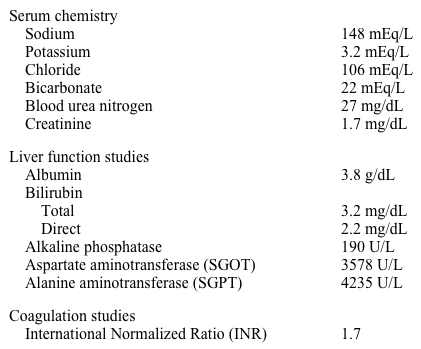A 44-year-old construction worker comes to the emergency department with nausea and fatigue over the last 2 days. He strained his back at work 7 days ago. He could not move for several days and took over-the-counter painkillers and applied hot packs. The patient still has significant back pain and limited mobility. He smokes 1 pack of cigarettes a day. He drinks alcohol daily and heavily on weekends. In addition, he also admits to using intravenous heroin on occasion.
He was hospitalized for pneumonia 6 months ago and treated with intravenous antibiotics. The echocardiogram during that admission showed normal left ventricular systolic function, mildly dilated right ventricle, and mild pulmonary hypertension.
His temperature is 37.2° C (99° F) , blood pressure is 94/50 mm Hg, and pulse is 112/min. There is mild scleral icterus. Several needle tracks are seen on both forearms. No heart murmurs are present. The lungs are clear. There is no abdominal distention. Moderate right upper-quadrant tenderness is present. The spleen is not palpable. There is no peripheral edema.
Laboratory results are as follows:
Which of the following is the most likely cause of this patient's current condition?
Definitions:
Weighted-Average Method
An inventory costing method that averages the cost of goods available for sale, used to determine the cost of goods sold and ending inventory.
Mixing Department
A specific section within a manufacturing setup where materials are combined to produce a product.
Equivalent Units
An approach in process costing that transforms units that are only partly finished into an equivalent number of entirely completed units, facilitating accounting procedures.
First-In, First-Out Method
An accounting method for valuing inventory where the first items purchased are the first ones removed from inventory, reflecting costs in the order they were incurred.
Q9: Laws passed by local governing bodies such
Q9: Correspondence is one of the types of
Q9: Use the distributive property to help simplify
Q9: When there is a major difference in
Q10: A 20-year-old college student is brought to
Q10: Perform the division by rationalizing the denominator
Q21: A 65-year-old man is admitted to the
Q32: A 43-year-old woman is being evaluated for
Q106: A 62-year-old man comes to the emergency
Q175: A 65-year-old man is brought to the